So, you want to gain strength, power, muscle, endurance, loss weight, or get shredded. All of these goals require certain techniques.
| SUPERSETS | ||||||||||||||||||||||||||||
| 1. It’s a pair of exercises performed one after another w/ no rest. | ||||||||||||||||||||||||||||
| 2. They are usually performed w/ antagonistic exercises, but the | ||||||||||||||||||||||||||||
| second exercise could be of the same muscle group. | ||||||||||||||||||||||||||||
| 3. They can also be pre/post exhaust or dropsets. | ||||||||||||||||||||||||||||
| STRAIGHT SETS | ||||||||||||||||||||||||||||
| The reps remains the same throughout the sets. | ||||||||||||||||||||||||||||
| PYRAMID SET | ||||||||||||||||||||||||||||
| During each set you increase the weight and decrease the reps. | ||||||||||||||||||||||||||||
| HIT | ||||||||||||||||||||||||||||
| 1. This method is used for weight training. | ||||||||||||||||||||||||||||
| 2. High-intensity training. | ||||||||||||||||||||||||||||
| 3. Each body part gets worked once a week. | ||||||||||||||||||||||||||||
| 4. You only do one set in the 8-12 REP range. | ||||||||||||||||||||||||||||
| 5. You’re going balls out heavy. | ||||||||||||||||||||||||||||
| TABATA | ||||||||||||||||||||||||||||
| 1. Developed by Dr. Tabata in Tokyo. | ||||||||||||||||||||||||||||
| 2. You take one exercise and do eight intervals in four minutes. | ||||||||||||||||||||||||||||
| 3. Exercise at you maximum capacity for 20 second. | ||||||||||||||||||||||||||||
| 4. Then slow your pace down for 10 second. | ||||||||||||||||||||||||||||
| 5. Repeat the exercise. | ||||||||||||||||||||||||||||
| BENEFITS | ||||||||||||||||||||||||||||
| A. Increase VO2 (the maximum amount of oxygen the body | ||||||||||||||||||||||||||||
| can use during a specified period of intense exercise. VO2 depends on one’s body weight and lungs strength. | ||||||||||||||||||||||||||||
| B. Increase anaerobic capacity. | ||||||||||||||||||||||||||||
| C. Raises your metabolism. | ||||||||||||||||||||||||||||
| D. Allow you to burn more body fat. | ||||||||||||||||||||||||||||
| E. Shorter workout | ||||||||||||||||||||||||||||
| F. Fun and engaging | ||||||||||||||||||||||||||||
| G. More stamina | ||||||||||||||||||||||||||||
| H. Increase lean body mass | ||||||||||||||||||||||||||||
| I. Increase physical strength | ||||||||||||||||||||||||||||
| DROP SETS | ||||||||||||||||||||||||||||
| During each set you decrease the weight and increase the reps. | ||||||||||||||||||||||||||||
| COMPOUND TRAINING | ||||||||||||||||||||||||||||
| 1. This is doing strength and power training on alternating days. | ||||||||||||||||||||||||||||
| 2. Power will increase under this technique. | ||||||||||||||||||||||||||||
| COMPLEX TRAINING | ||||||||||||||||||||||||||||
| 1. This is doing strength and power training in the same workout. | ||||||||||||||||||||||||||||
2. Strength and size will increase under this technique.
|
||||||||||||||||||||||||||||
| BILATERAL TRAINING | ||||||||||||||||||||||||||||
| 1. This is lifting with either arms or legs simultaneously. | ||||||||||||||||||||||||||||
| 2. Allows a greater force development in the muscle. | ||||||||||||||||||||||||||||
| 3. You can move more weight. | ||||||||||||||||||||||||||||
| LATERAL TRAINING | ||||||||||||||||||||||||||||
| 1. This is lifting with one arm or leg at a time. | ||||||||||||||||||||||||||||
| PERIODIZATION | ||||||||||||||||||||||||||||
| This method is dividing training into specific periods, usually lasting eight to 12 weeks. | ||||||||||||||||||||||||||||
| These periods are used for achieving unique goals. | ||||||||||||||||||||||||||||
| A. Mass | ||||||||||||||||||||||||||||
| 1. This is when you focus on weight gain or body part measurements goals. | ||||||||||||||||||||||||||||
| 2. In this period your rep range should be between 8-12. | ||||||||||||||||||||||||||||
| 3. This period should last for about four months. | ||||||||||||||||||||||||||||
| B. Definition | ||||||||||||||||||||||||||||
| 1. This is your leaning-out period. | ||||||||||||||||||||||||||||
| 2. In this period your focus is on increasing cardio and decreasing cards. | ||||||||||||||||||||||||||||
| 3. You may increase your ab workout. | ||||||||||||||||||||||||||||
| 4. This period should last for about four months. | ||||||||||||||||||||||||||||
| C. Strength | ||||||||||||||||||||||||||||
| 1. This is when you focus on boosting one exercise per body part. | ||||||||||||||||||||||||||||
| 2. At this point you’re using heavier weights with lower reps | ||||||||||||||||||||||||||||
| 3. This period should last for about four months. | ||||||||||||||||||||||||||||
| D. Intensity | ||||||||||||||||||||||||||||
| 1. This period is used to improve lagging muscles | ||||||||||||||||||||||||||||
| 2. In every workout you would be doing all giant, super, and dropsets throughout every workout. | ||||||||||||||||||||||||||||
| 3. This period should last only two to six weeks. | ||||||||||||||||||||||||||||
| E. Fitness | ||||||||||||||||||||||||||||
| 1. This is when you take a break from lifting heavy giving your joints and tendons rest. | ||||||||||||||||||||||||||||
| 2. You would focus on high reps, circuit training, functional training, or calisthenics. | ||||||||||||||||||||||||||||
| 3. This period should last between a week to a month. | ||||||||||||||||||||||||||||
| LINEAR PERIODIZATION | ||||||||||||||||||||||||||||
| 1. This period begins with light weight done with high reps. | ||||||||||||||||||||||||||||
| 2. It ends with heavy weight done with low reps | ||||||||||||||||||||||||||||
| 3. The plan is made up of four phases. | ||||||||||||||||||||||||||||
| Week 1: TO BUILD ENDURANCE | ||||||||||||||||||||||||||||
| Light weight for 15-20 reps per set | ||||||||||||||||||||||||||||
| Week 2: TO BUILD HYPERTROPHY | ||||||||||||||||||||||||||||
| Increase the weight and and drop to 6-12 reps per set | ||||||||||||||||||||||||||||
| Week 3: TO BUILD STRENGTH | ||||||||||||||||||||||||||||
| Increase the weight and and drop to 1-6 reps per set | ||||||||||||||||||||||||||||
| Week 4: TO BUILD POWER | ||||||||||||||||||||||||||||
| Increase the weight and and drop to 1-3 reps per set | ||||||||||||||||||||||||||||
| 4. At the end of week four you rest, then start over in 1-2 weeks with training | ||||||||||||||||||||||||||||
| for endurance. | ||||||||||||||||||||||||||||
| 5. This training method was designed for elite athletes. | ||||||||||||||||||||||||||||
| 6. The plan is to maximize strength and power. | ||||||||||||||||||||||||||||
| REVERSE LINEAR PERIODIZATION | ||||||||||||||||||||||||||||
| 1. This plan runs the linear scheme backwards. | ||||||||||||||||||||||||||||
| 2. It begins with heavy weight done with low reps. | ||||||||||||||||||||||||||||
| 3. It ends with light weight done with high reps | ||||||||||||||||||||||||||||
| 4. This plan is to maximize endurance strength | ||||||||||||||||||||||||||||
| UNDULATING PERIODIZATION | ||||||||||||||||||||||||||||
| 1. This plan is just a way of confusing the muscle. | ||||||||||||||||||||||||||||
| 2. The linear and reverse linear gradually increase or decrease weight and rep ranges. | ||||||||||||||||||||||||||||
| 3. This plan calls for weight and rep ranges to be different at every workout. | ||||||||||||||||||||||||||||
| 4. Some days you go heavy with low reps, on other days you can go light with high reps, and some days you can go moderate with moderate rep ranges. | ||||||||||||||||||||||||||||
| 5. This plan is good for developing strength, power, muscle mass. | ||||||||||||||||||||||||||||
| 6. This is due to the cycling of strength training repeatedly from day to day, which keeps the muscle from not getting used to the stimulus. | ||||||||||||||||||||||||||||
| FILTHY FIFTY | ||||||||||||||||||||||||||||
| 1. This method is designed to build muscle and aid in joint healthy and recovery. | ||||||||||||||||||||||||||||
| 2. It should be done with light to medium weights. | ||||||||||||||||||||||||||||
| 3. The next day should be a rest day. | ||||||||||||||||||||||||||||
| 4. The workout is done with 10 different exercises of 50 reps each. | ||||||||||||||||||||||||||||
| 5. Your goal is to finish in as little time as possible. | ||||||||||||||||||||||||||||
| BULGARIAN METHOD | ||||||||||||||||||||||||||||
| 1. In the ’70s and ’80s, the Bulgarian weightlifting team dominated world competition. | ||||||||||||||||||||||||||||
| 2. You can use this method to improve on your bodybuilding workouts. | ||||||||||||||||||||||||||||
| 3. It begins with the the law of specificity. | ||||||||||||||||||||||||||||
| 4. It’s the believed in order to get better at something, you have to perform it over and over. | ||||||||||||||||||||||||||||
| These are the basics of the method | ||||||||||||||||||||||||||||
| A. To get stronger at a lift, you should perform it at great frequency | ||||||||||||||||||||||||||||
| B. Do the lift six days a week w/ for workouts per day. | ||||||||||||||||||||||||||||
| C. To get stronger at a single rep, do lifts at near-maximum weights. | ||||||||||||||||||||||||||||
| D. To avoid injuries and over-training, alternate between heavy and light cycles. | ||||||||||||||||||||||||||||
| To apply to bodybuilding | ||||||||||||||||||||||||||||
| A. No more than six exercises per routine. | ||||||||||||||||||||||||||||
| B. Focus on compound exercises, and push all sets to failure. | ||||||||||||||||||||||||||||
| C. Perform the routine four to six days per week. | ||||||||||||||||||||||||||||
| D. You can do one exercise (5 x 10), multiple times in a day. | ||||||||||||||||||||||||||||
| THE DOUBLER | |||||
| 1. Pick a number of exercises and reps to perform. | |||||
| 2. On the first exercise you do 5 reps. | |||||
| 3. the next exercise you do 10 reps. | |||||
| 4. The following exercise you do 20 rep. | |||||
| 5. and so on… | |||||
| GAUNTLETS | ||||||||
| 1. Pick a number of exercises, sets and reps to perform with the same equipment. | ||||||||
| 2. on the second set you do the same exercises and reps, but increase the weight. | ||||||||
| 3. On the third set you increase the weight. | ||||||||
| 4. There should be little rest periods between exercises. | ||||||||
|
|
||||||||
| FULL-BODY 100 | |||||
| 1. You take two body weight exercises. | |||||
| 2. Perform both for ten reps in one set. | |||||
| 3. Then do four more sets to complete 100 reps. | |||||
| 3. This should be down for time. |
| POST-ACTIVATION POTENTIATION | |||||||||
| 1. This is a exercise that immediately impacts the performance of the exercise that follows. | |||||||||
| 2. Your CNS will be in for the fight of it’s life. | |||||||||
| 3. This makes the muscle have to use more fibers to complete the task. | |||||||||
| EXERCISE | SETS | REPS | |||||||
| Sprints | 4 | 50m | |||||||
| Barbell squats | 4 | 6, 8, 12, 15 | |||||||
| Leg press | 4 | 4 | |||||||
| THRUSTER | 1 | 100 | |||||||
| 4. The first exercise excite the fast-twitch fibers in your legs, and get them prime for growth. | |||||||||
| 5. The second and third move will cause the growth. | |||||||||
| 6. The finale exercise is a muscle-swelling finisher. | |||||||||
| 7. Keep the rest period short on the finisher. |
| WRECK BAG | ||||||||||
| 1. This is a sandbag filled with rubber pellets. | ||||||||||
| 2. It’s a favorite in obstacle course race. | ||||||||||
| 3. The workout burn fat, improve anaerobic capacity, agility, coordination, explosiveness, and speed. | ||||||||||
| 4. The bags comes in different weights and can be lifted, tossed, and carried to give you a full body workout. |
| ROPE TRAINING | ||||||||
| 1. If you want to improve your stamina, power, and speed. | ||||||||
| 2. It’s great for burning calories, improving agility, and coordination. | ||||||||
| 3. You don’t need a gym or a lot of space | ||||||||
| How to jump: | ||||||||
| I. HEIGHT | ||||||||
| A. Place one foot on the middle of the rope. | ||||||||
| B. Pull the handles up untill the rope is taut. | ||||||||
| C. If your a beginner the handles should reach the shoulders | ||||||||
| D. If you’re more advance aim for you nipple line. | ||||||||
| II. STAND TALL | ||||||||
| A. Keep your weight over the balls of your feet. | ||||||||
| B. keep hips, knees, and ankles relax. | ||||||||
| C. Tuck your elbows close to your rips. | ||||||||
| D. Keep your hands slightly in front of your hips. | ||||||||
| III. ROTATION | ||||||||
| Turn with your wrists, not at the elbows or shoulders. | ||||||||
| IV. TIMING IS EVERYTHING | ||||||||
| Turn first, then jump. You’ll will have to jump higher, if you jump to early. | ||||||||
| V. TENSION | ||||||||
| Tension leads to fatigue and clumsy execution. Try to relax from head to toe. |
| ESCALATING DENSITY TRAINING | |||||||||
| 1. The workout is to be performed four times a week. | |||||||||
| 2. You will be pairing antagonist body parts together. | |||||||||
| 3. You can do chest and back, legs and shoulders, or upper and lower body. | |||||||||
| 4. Pick one exercise per body part, and alternate sets between the two moves for 15 minutes. | |||||||||
| 5. Record how many reps performed and weight you used for each exercise. | |||||||||
| 6. This is you benchmark to beat next week. | |||||||||
| 7. The goal is to do more reps not move more weight. | |||||||||
| 8. One you exceeded your first workout by 20%, increase the load by 5 pounds | |||||||||
| 9. Then set a new benchmark. | |||||||||
| 10. Follow this program for 8-12 weeks. | |||||||||
| 11. This technique is going to hurt like hell. |
SUSPENSION BAND TRAINING
This is a technique that uses body weight and gravity to perform a full-body workout by using unstable straps that are mounted overhead. It’s very good for improving your stability. Have a knowledge of how your muscles works and conditioning before attempting this type of training.
NEGATIVE TRAINING
It’s time to think negatively to make positive gains. The negative potion of your lift occurs with the lowering of the weight, and lengthening of the muscles. If you don’t drop the weight your muscles remains under tension. You want to slow down the lowering of the weight by taking 3 to 6 seconds of each rep.
Use these methods to improve your negative gains.
1. BEYOND FAILURE
Do 6-12 reps, and stop when you can’t do another rep. then have your spotter
help you raise the weight, because your focus isn’t on the positive. Keeping
good form, lower the weight slowly, by taking 3 to 6 seconds on the descent.
2. FORCED POSITIVE
Select a weight that’s heavier than usual for you. I say you add no more than 25%. On every rep your spotter will help you on the lift. Lower the weight with control over 3 to 6 seconds. Do 6-12 negative reps. You can also do this technique on some machines. Machine exercises are great because you don’t need a spotter. All you have to do is lift the weight bilateral and lowering it unilaterally. on the leg press you can raise with both legs and lower with one. Do 6-10 reps with one leg or by alternating legs. You can also do this with a few free-weight exercises, but you’ll have to lose form on the positive. An example, do a regular deadlift on the positive, and a stiff-leg deadlift on the negative, or a standing clean on the positive and a barbell curl on the negative.
3. FORCED NEGATIVE
On forced negative you spotter puts pressure on the negative portion of you lift, by pushing or pulling down on the resistance. This makes the resistance harder to overcome. On a barbell curl, your spotter would push up on the negative, to slow your descent to at least 3 to 6 seconds.
4. NEGATIVE FOCUS
When using this method the emphasize as placed on the rep cadence. On the positive lift the rep cadence should be two seconds, and on the negative portion the rep cadence should be four second.
5. NEGATIVE ONLY
Have your spotter assist you in lifting a weight you can lower to a count of eight second. At the top of the lift, the weight is transfer to you, now take eight seconds to lower it. Have your spotter lift the weight back up comletely.
Always perform these lifts with a spotter. You can use free weights or machines.
REPS & SETS TO GOALS
The number of reps and sets you perform helps in determining the goal in which you’re tring to reach.
POWER
keep your reps between 1-3 per set.
STRENGTH
keep your reps between 1-6 per set.
HYPERTROPHY
keep your reps between 8-12 per set.
ENDURANCE (GETTING LEAN)
keep your reps between 12-20 per set.
The number of sets you perform in a workout should depend on your fitness level and goals. You need to find a balance of high- and moderate intensity sets for maximum gains. Do no more than 20 sets per muscle group, and less than 40 sets per workout. Training to long can cause injuries and diminish gains. If you’re just beginning to lift. Do 3-24 sets per workout, and a more experience lifter should perform 10-40 sets per workout.
REST PERIODS
This is my biggest disagreement I have with the fitness industry. We are told that our rest period should accommodate our goals. Our goals of strenght, hypertrophy. or endurance (getting lean) requires replenisment of adenosine triphosphate (known as ATP. this is the energy source that fuels muscle
cells). In order to do this our nuscles needs enough time to rest, to replenish ATP for its next movement. Use these rest schemes to reach your goal.
POWER
keep you rest period between 2-3 minutes
STRENGTH
keep you rest period between 2-3 minutes
HYPERTROPHY
keep you rest period between 1-2 minutes
ENDURANCE (GETTING LEAN)
keep you rest period below :30 seconds.
As stated earlier, I disagree with this rest theory. I began training in my teens. At this time I had no clue what I was doing, but I never followed anyone in the the gym. I did what made me comfortable. I always worked out to move and grow. I went to the gym to workout not make friends. I did 3-4 sets with 10-12 reps. My rest period for a set was always less then :45 seconds. This kepted oxygenated blood in my muscles throughout the workout, and your muscles need oxygen to grow. Once you pickup heavy shit and but it down. You will see physical changes in yourself.
FLOW
This form of training is taking two or three exercises that creates a natural transition between them. It’s a combination of supersets, trisets, and complex training. The workouts are quick and keeps the heart rate elevated. The purpose of these exercises are to done in a way that they flow into
each other.
WORKOUT
SETS: 5
REPS: 5
REST: :30
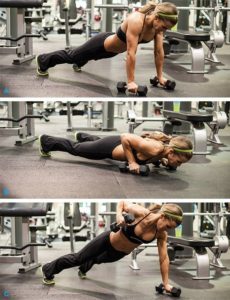
Dumbbell pushups to rows to work the chest and back.
Do 5 reps of pushups and one row on each side.
WORKOUT
SETS: 5
REPS: 5
REST: :30
A. DUMBBELL BENT-OVER ROW
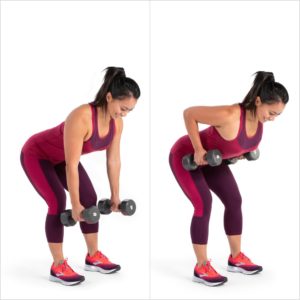
B. DUMBBELL PUSHUP
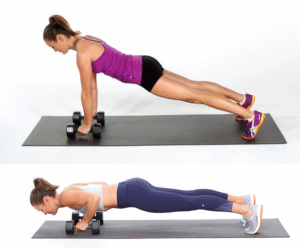
C. DUMBBELL DEADLIFT
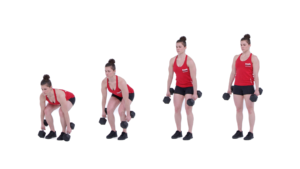
Do 5 reps of each exercise, with a :30 second rest between each round.
This workout hits the back, chest, and legs.
WORKOUT
SETS: 5
REPS: 5
REST: :30
A FRONT RAISE
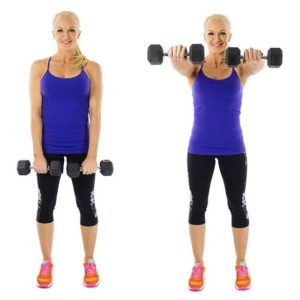
B. LATERAL RAISE
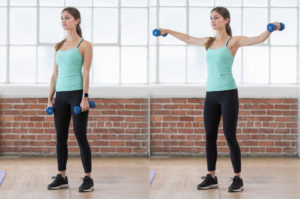
Do 5 reps of each exercise, with a :30 second rest between each round.
This workout hits the front and sides of the shoulders. This technique involves one piece of equipment, little space, and short rest periods. It’s good for building strenght and promotes weight loss.
